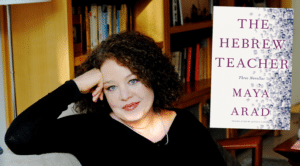Israelis in America
July 15, 2024 in Library Corner
By Robin Jacobson.
For years Maya Arad has won enthusiastic praise for her fiction, even being described in the Israeli newspaper Haaretz as “the finest living author writing in Hebrew.” That alone is reason to dive into The Hebrew Teacher, the first of her books to be translated into English. Readers may be surprised, however, to discover that the book’s three wise and witty novellas are set in the United States rather than in Israel. They offer insight into the Israeli diaspora, while perceptively exploring personal and political conflicts between older and younger generations.
“The Hebrew Teacher”
 The title novella, The Hebrew Teacher, feels all-too-relevant in this turbulent year of anti-Israel protests on college campuses.
The title novella, The Hebrew Teacher, feels all-too-relevant in this turbulent year of anti-Israel protests on college campuses.
Ilana, an Israeli who moved to the United States in 1971, is a longtime Hebrew instructor at a Midwestern university. In her early years in America, she recalls, people would give her “admiring looks” when she told them she was Israeli. Each year, she organized a popular campus festival for Yom Ha’atzmaut, Israel Independence Day, complete with falafel, hummus, and bright blue-and-white balloons.
In contrast, when the story opens, Ilana is lamenting that it “wasn’t a very good time for Hebrew.” It’s a year or so after the 2014 Gaza War. Enrollment in Ilana’s Hebrew classes has dwindled to such low levels that she fears for continuation of the language program. Israel, she worries, “is a tough sell these days.”
After devoting decades to teaching Hebrew, Ilana is distressed to see her life’s work losing relevance and respect. Her angst is exacerbated by a prickly relationship with the new Hebrew and Jewish literature professor, a stridently non-Zionist Israeli who opposes Ilana’s Israeli culture initiatives.
“A Visit” and “Make New Friends”
The other novellas, A Visit (Scenes) and Make New Friends, center on Israeli families living in Northern California. In A Visit, Miriam flies in from Israel for a three-week stay with her son Yoram, daughter-in-law Maya, and toddler grandson whom she has never met. Yoram and Maya are surprisingly unwelcoming.
As a result, Miriam ends up spending a lot of time with another Israeli woman, Malka, whom she met on the plane, and Malka’s daughter-in-law. She can’t help envying Malka the warm and easy relationship she enjoys with her family. Eventually, we learn more about the sources of the tension in Miriam’s family.
In Make New Friends, Efrat tries to help her daughter Libby navigate the cruelties of middle school social life, including social media. In her zeal to make Libby happy and her anger at the way Libby’s classmates treat her, Efrat seriously oversteps. Anyone who has been an adolescent or parented one may painfully recognize themself in this story.
Maya Arad
Born in Israel in 1971, Arad spent her early childhood on Kibbutz Nahal Oz, one of the kibbutzim near Gaza attacked on October 7. She speaks six languages and earned a Ph.D. in linguistics from University College London. She is the author of 11 books of Hebrew fiction, as well as studies in linguistics and literary criticism.
Arad and her husband, Reviel Netz, a Stanford University professor of Classics, intended to return to Israel after finishing their studies in the United Kingdom. Instead, says Arad, they were so stunned by the election of Netanyahu as Prime Minister in 1996, just a short time after the assassination of Prime Minister Rabin, that they continued to live overseas. For the past 20 years, they have resided in California, where Arad is Writer in Residence at Stanford’s Taube Center for Jewish Studies.
The Hebrew Teacher will surely earn Arad English-reading fans. Happily, another Arad novel, Shanim Tovot (Happy New Years), will be published in English translation in 2025.